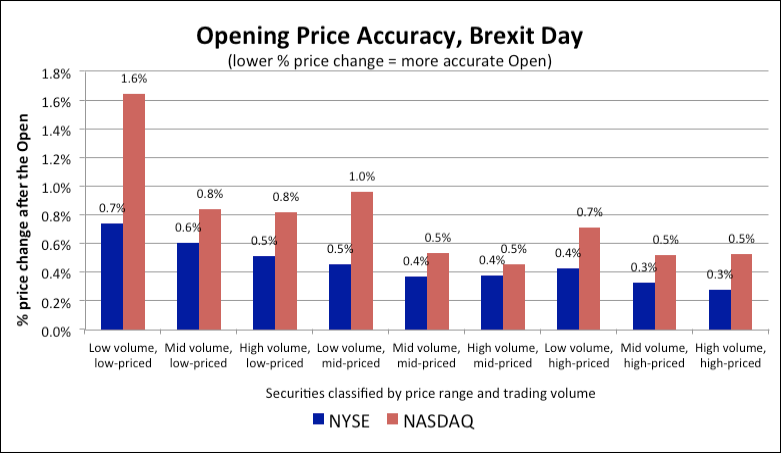
The Exchange
Brexit Market volatility demonstrates the value of NYSE listing & trading model
Becoming a public company is the culmination of years of hard work, innovation and investment and the event represents a defining moment in a company’s progression.
But it also requires new decisions, because where a company chooses to list can have meaningful impact on the quality of how a stock trades, particularly during times of economic uncertainty and market volatility.
As financial markets have evolved over the last two decades, most global exchanges moved to exclusive electronic models. In fact, the New York Stock Exchange is the only listings exchange with an active trading floor and a model that combines technology with human judgment through the efforts of its Designated Market Makers (DMMs).
NYSE DMMs stabilize and protect the capital of NYSE-listed companies. They are responsible for maintaining a fair and orderly market for listed securities of all sizes. They have much higher trading obligations than traditional market makers. They closely monitor the markets in the issues they are responsible for, and use their own capital to provide liquidity, minimize market imbalances, create pricing efficiency and dampen volatility.
While markets today are largely electronic, the DMM conducts the NYSE’s unique opening and closing process where they can commit capital to satisfy market orders before continuous trading begins and at the end of trading. Their role in this process brings more accurate price discovery that is consistent with investor supply and demand by ensuring that all market orders are executed, in contrast to exchanges with purely electronic opening and closing processes.
NYSE DMMs deliver value to investors and listed companies every day, but the benefit they deliver becomes even more meaningful and apparent during volatile markets.
In the early hours of Friday, June 24, 2016, the United Kingdom released the results of its European Union (EU) membership referendum, also known as Brexit. The UK elected to leave the EU, sparking waves of uncertainty and selling pressure in global capital markets. The result was the single largest market event in more than two years, with US equity market volatility spiking more than 40 percent.
As Americans woke to the news in Europe, the NYSE DMMs were actively preparing for a turbulent day of trading, beginning with the market open. Setting the price during the open is crucial because it represents both a market data reference point as well as a key liquidity event. There is also significant retail trading in the open due to individuals placing online orders from the previous evening.
When facilitating the open of trading for NYSE-listed securities, NYSE DMMs consistently deliver the best price discovery. This means they are able to consistently establish an opening price that reflects the actual supply and demand for the stock. This means that after NYSE-listed securities open, there is less dramatic price movements in the trades that follow. This also means that investors trading NYSE-listed securities are more likely to get a fair and accurate price when trading both in the open and once continuous trading begins.
The accuracy of an opening price can be measured by comparing the price of the opening trade to the average price over the subsequent five minutes. A smaller price change after the open indicates a more accurate opening Price was established.
The chart below demonstrates NYSE’s superiority, irrespective of a stock’s price range or trading volume, in achieving accurate opening prices on average days and during the volatility on Friday, June 24, 2016, as compared to similar securities that list on the Nasdaq.

Source: Consolidated tape, NYSE, June 24, 2016
Low-priced = less than $20; Mid-priced = $20 to $50; High-priced = More than $50
Low volume = less than 1MM shares/day; Mid volume = 1 to 3MM shares/day; High volume = Over 3MM shares/day
In fact, on that day alone, in the five minutes after opening a security, NYSE experienced less than half of the volatility of NASDAQ. This means that investors trading stocks on NASDAQ could have potentially saved quite a bit if they had received the NYSE level of price discovery.
NYSE’s DMMs provide a valuable service to the investing public and the public companies they serve. The NYSE market model’s unique contribution to market quality is another reason why the NYSE is the premier exchange group and the venue traders and investors look to for market stability during times of global economic uncertainty and market stress.